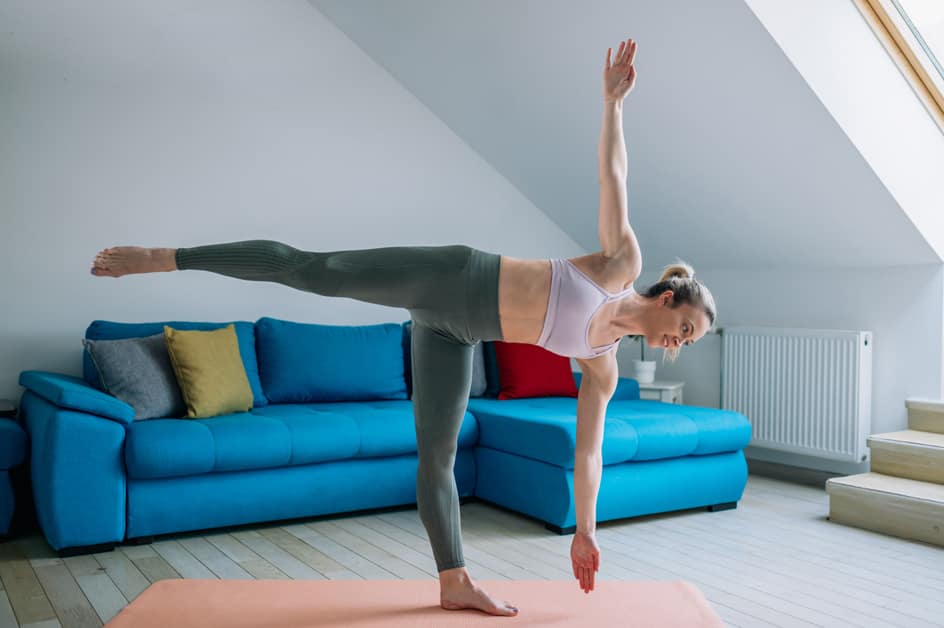Introduction
Ageing brings balance and stability as key factors. Balance helps us move safely and avoids injury from falls. However, for many seniors knee pain makes balance exercises difficult.
But, there are exercises that can help seniors improve balance without much strain on their knees. These exercises focus on the core strength, agility and hip stability that are essential for balance. With proper strength training and stretching, one can reduce knee pain and work on balance.
Consult a doctor or physical therapist before beginning any routine. Here is an overview of some exercises suitable for seniors with knee pain who want to improve balance:
- Core Strength Exercises
- Agility Exercises
- Hip Stability Exercises
Balance Exercises
Balance exercises are essential for senior fitness. Especially for those with knee pain, these exercises can be beneficial. To boost balance, seniors need to build up the strength in their legs. Doing balance exercises can help to increase stability and reduce knee pain.
Here are the top balance exercises for seniors:
Standing on one foot
Stand with feet hip-width apart. Shift your weight to one foot. Keep arms out or near sides for balance. Lift opposite foot a few inches up. Hold the position (up to 30 secs). Close eyes or lift foot higher for difficulty.
To make it harder, try standing on a pillow or wear ankle weights. Wobble board or rocking chair adds extra challenge.
Standing on one foot helps improve balance and strengthens leg muscles. This boosts coordination and flexibility. Add this exercise to your regular routine for better coordination!
Heel-to-toe walking
Heel-to-toe walking is a great balance exercise. It requires little equipment and can be done by people of all ages.
To begin, find a flat surface with no objects. Stand with one foot in front of the other. Heels should touch toes. Posture should be good and weight distributed evenly. Step forward as if you are walking on a tightrope. Start slow and speed up as you become more comfortable.
It is recommended to do several repetitions. Turn around at a wall or corner to balance muscle groups. Use arms for support but keep them close to the body. As balance improves, add time limits or alternate feet while walking. Make sure to keep eyes on objects further away when transitioning steps. If walking outside, ensure the area is well lit.
Standing knee bends
Standing knee bends are an easy exercise for seniors with knee pain that requires no equipment. The aim is to improve posture and balance. Stand behind a counter or sturdy chair for support. Put one foot forward and the other back, with both feet hip-width apart. Bend the back leg until the thigh is parallel to the floor. Balance for 5 seconds, then slowly return to the start position. Do 10 reps with each leg. Increase reps or time in the bent position as you get stronger.
Variations such as crossing your arms over your front leg or raising up on your toes add difficulty. Engage your core muscles throughout every rep. This will help you balance with your entire body, leading to better form and stability.
Single-leg stand
For those with knee pain, the single-leg stand is one of the best balance-improving exercises. You’ll need to balance on one leg, with the other bent at the knee, pressing against a wall or furniture. Lift that leg off the ground while you hold yourself up. Do this 10 times on each side. When you build strength and stability, increase to 30 repetitions. To make it harder, use a light medicine ball or ankle weight. Stand in front of a mirror for posture checks.
Single-leg hop
The single-leg hop is great for seniors with knee pain. Stand straight with hands on hips and feet parallel. Lift one leg slightly off the ground and hop up and down. Focus on landing softly, while keeping balance. Use a railing or support to help you balance or slowly increase the number of hops. Do the exercise with both legs to give muscles an equal workout.
Benefits of Balance Exercises
Balance exercises for seniors with knee pain can be great! They can:
- Increase balance, agility, and coordination
- Reduce the risk of falls
- Improve leg strength
- Increase range of motion
- Increase flexibility
All of this adds up to improved general wellbeing. Try out some balance exercises today!
Improved coordination
Balance exercises help improve coordination and stability. They also build strength in the legs and core, increasing balance and body control. Balance exercises are important for keeping mobility, especially for older adults who may have limited movement due to joint pain or weak muscles.
Seniors with knee pain can do exercises like stance shifting, leg lifts, marching in place, single-leg stands, cross the midline movements and walking heel-to-toe. Stance shifting is standing on one foot and then the other while holding onto a support. Leg lifts involve standing up straight while lifting each leg straight up to either side or the front. Marching in place means raising your knees one at a time as high as possible.
Single-leg stands involve raising one leg parallel with the ground and holding onto something over head for support. Cross the midline movement involves swinging each arm across opposite legs and patting each thigh. Walking heel toe means stepping alternating heels then toes along an imaginary line. This helps seniors read tiny details on uneven terrain.
Improved posture
Good posture is a must for balance, especially for elderly individuals. Balance exercise help build up muscles which aid good posture and lessen the chances of falling.
Yoga or Pilates can be useful for strengthening core muscles in the abdomen, back and hips – helping keep the body upright. Walks are great for improving posture too, as they help strengthen core muscles. Other exercises such as tai chi and dance classes can also help by teaching how to align the body properly; this encourages better balance and reduces knee pain.
Reduced risk of falls
Balance exercises are essential for everyone. They help with coordination, flexibility, and reduce the risk of falls. For seniors in particular, balance exercises become increasingly more important as balance can deteriorate with age.
For seniors who have knee pain, there are balance exercises they can do to protect against injuries. These exercises help build proprioceptive awareness. This is when the body senses its own movements and helps the brain understand where the body is. This can stop falls.
Improved balance can lead to better overall health, more independence, and less risk of broken bones or trauma from falls. Balance exercises can also strengthen muscles around joints like hips, ankles, and feet to ease knee pain.
Examples of balance exercises for seniors include:
- Single knee lifts. Stand with legs shoulder width apart behind a sturdy chair. If needed, hold onto the chair slightly. Lift one knee up to hip level, then lower it back down while keeping balance steady on both feet.
- TIP toe walk. Hold onto a wall if needed. Lift heel off ground while standing on toes. Then move forward walking 10 steps.
- Step Ups. Stand in front of a few stairs and prop left hand onto railing. Put right foot onto first step and set back heel down into each step until reaching top step.
Knee Pain Prevention
Knee pain can be a real struggle for seniors. But don’t worry! There are lots of balance exercises that can help and reduce the pain. Let’s look at the best balance exercises for seniors with knee pain. Here’s how to make sure your knees stay safe while you exercise:
Warm up before exercising
Seniors with knee pain must warm up before starting a workout. This increases the blood flow, making the joints and muscles less stiff and sore. Also, there’s less chance of getting injured. Warm-up for 10-15 minutes with light jogging, jumping jacks, or slow walking.
Stretching helps loosen the muscles and joints; do it dynamically and hold each stretch for twenty seconds.
Do leg swings and calf stretches to target the muscles causing knee pain. Squats and lunges can strengthen the glutes and quads, giving stability to the knee joint while walking and climbing stairs. Downward dog is a gentle yoga position which stretches tight muscles while giving balance training benefits. If any of these exercises cause discomfort or pain in the knees, take it easy.
Wear appropriate footwear
When exercising, the correct shoes are key to reducing knee strain. Pain in the knees and ankles can be caused by shoes which are the wrong size, or too much cushioning (or none) in the wrong areas.
Find some athletic shoes with loads of arch support and a tread that helps with balanced running/walking on any surface. Shock absorbent insoles can also help ease knee pain in seniors. Don’t forget to change your running shoes every few months for best performance.
Use a chair or wall for support
Using a chair or wall for support helps seniors be safer and more upright while doing exercises to reduce knee pain. It also gives feedback to help improve posture, strength and balance. This feedback encourages seniors and boosts their proprioception, the sense of where their body is in space.
When using a chair for an exercise, ensure it is stable and doesn’t swivel or tip easily. Make sure the wall is tall enough to provide full support when you move up and down. Avoid tables and counters as they can collapse with pressure.
Common exercises with chairs include steps. Walk up, down or sideways while holding onto the back of the chair for stability. Other exercises include:
- Sit-to-stands with feet slightly apart and feet flat on the floor. Press against the back of the chair before rising.
- Heel raises while holding onto the back legs of the same chair.
- Leg extensions, gripping under thigh/knee area for balance.
- Half lunges, placing hands on back legs of same chair.
- Ankle rolls, rotating ankles clockwise and counterclockwise.
Doing these exercises correctly can improve knee stability, muscle strengthening and pain relief. Plus regular stretching routines tailored to each person’s mobility needs.
Conclusion
For seniors with knee pain, it can be hard to find the right balance exercises. But, with the proper strategies and tips, they can still stay physically active and enjoy the gains of exercise. Working with a physical therapist can help them craft a personalized exercise plan that is suited to their individual needs and objectives.
The exercises recommended here are all good for seniors, even if they don’t have knee pain. They are designed to strengthen lower body strength, flexibility, and stability while decreasing pain in the knee joints. With dedication and consistency, seniors can get the rewards of staying active, while at the same time reducing the risk of injury or pain flare-ups.
Frequently Asked Questions
Q: What balance exercises are best for seniors with knee pain?
A: For seniors with knee pain, exercises that focus on balance and flexibility are best. Examples include chair squats, standing calf raises, and wall push-ups. Additionally, balance-training exercises such as the single-leg stand will help build strength and stability in the knee.
Q: How often should seniors with knee pain do balance exercises?
A: Generally, it’s recommended that seniors with knee pain do balance exercises 2-3 times per week. However, it’s important to check with a doctor before beginning any exercise program.
Q: Do balance exercises help reduce knee pain?
A: Yes, balance exercises can help reduce knee pain. By strengthening the muscles around the knee, balance exercises can help improve stability, reduce inflammation, and decrease the likelihood of injury.





